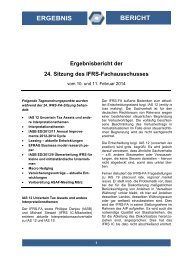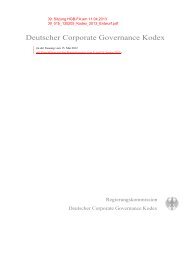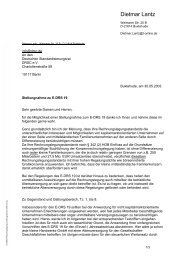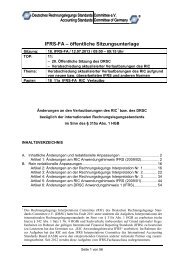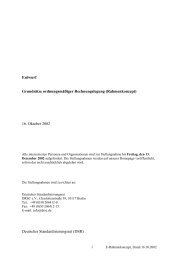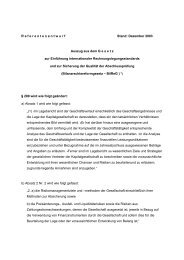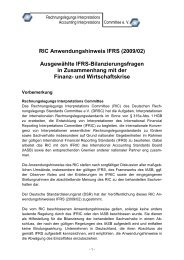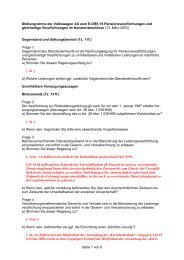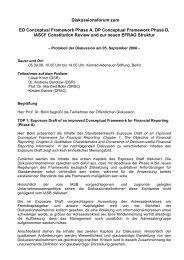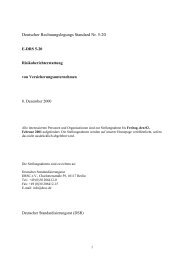Classification and Measurement: Limited Amendments to IFRS 9
Classification and Measurement: Limited Amendments to IFRS 9
Classification and Measurement: Limited Amendments to IFRS 9
Create successful ePaper yourself
Turn your PDF publications into a flip-book with our unique Google optimized e-Paper software.
CLASSIFICATION AND MEASUREMENT: LIMITED AMENDMENTS TO <strong>IFRS</strong> 9 (PROPOSED AMENDMENTS TO <strong>IFRS</strong> 9 (2010))<br />
Sales that occur for other reasons may also be consistent with a business model<br />
whose objective is <strong>to</strong> hold financial assets in order <strong>to</strong> collect contractual cash<br />
flows if such sales are infrequent (even if significant) or insignificant both<br />
individually <strong>and</strong> in aggregate (even if frequent). However, if more than an<br />
infrequent number of sales are made out of a portfolio, the entity needs <strong>to</strong> assess<br />
whether <strong>and</strong> how such sales are consistent with an objective of collecting<br />
contractual cash flows. Sales of financial assets may be consistent with the<br />
objective of collecting contractual cash flows if the sales are made close <strong>to</strong> the<br />
maturity of the financial assets <strong>and</strong> the proceeds from the sales approximate the<br />
collection of the remaining contractual cash flows.<br />
B4.1.4 The following are examples of when the objective of an entity’s business model<br />
may be <strong>to</strong> hold financial assets <strong>to</strong> collect the contractual cash flows. This list of<br />
examples is not exhaustive. The examples are not intended <strong>to</strong> discuss all fac<strong>to</strong>rs<br />
that may be relevant <strong>to</strong> the assessment of the entity’s business model nor specify<br />
the relative importance of the fac<strong>to</strong>rs.<br />
Example Analysis<br />
Example 1<br />
An non-financial entity holds<br />
investments <strong>to</strong> collect their<br />
contractual cash flows but would sell<br />
an investment in particular<br />
circumstances. The funding needs of<br />
the entity are predictable <strong>and</strong> the<br />
maturity of its financial assets is<br />
matched <strong>to</strong> its estimated funding<br />
needs.<br />
In the past, sales have typically<br />
occurred when the credit quality of<br />
the financial assets has deteriorated<br />
such that the assets no longer meet<br />
the entity’s documented investment<br />
policy. In addition, infrequent sales<br />
have occurred as a result of<br />
unanticipated funding needs.<br />
Reports <strong>to</strong> key management<br />
personnel focus on the credit quality<br />
of the financial assets. The entity<br />
also moni<strong>to</strong>rs fair values of the<br />
financial assets, among other<br />
information.<br />
19<br />
Although an entity may consider,<br />
among other information, the<br />
financial assets’ fair values from a<br />
liquidity perspective (ie the cash<br />
amount that would be realised if the<br />
entity needs <strong>to</strong> sell assets), the<br />
entity’s objective is <strong>to</strong> hold the<br />
financial assets <strong>and</strong> collect the<br />
contractual cash flows. Some sales<br />
Sales in response <strong>to</strong> deterioration in<br />
the assets’ credit quality such that<br />
they no longer meet the entity’s<br />
documented investment policy or<br />
infrequent sales resulting from<br />
unanticipated funding needs, even if<br />
such sales are significant, would not<br />
contradict that objective.<br />
continued...<br />
� <strong>IFRS</strong> Foundation



